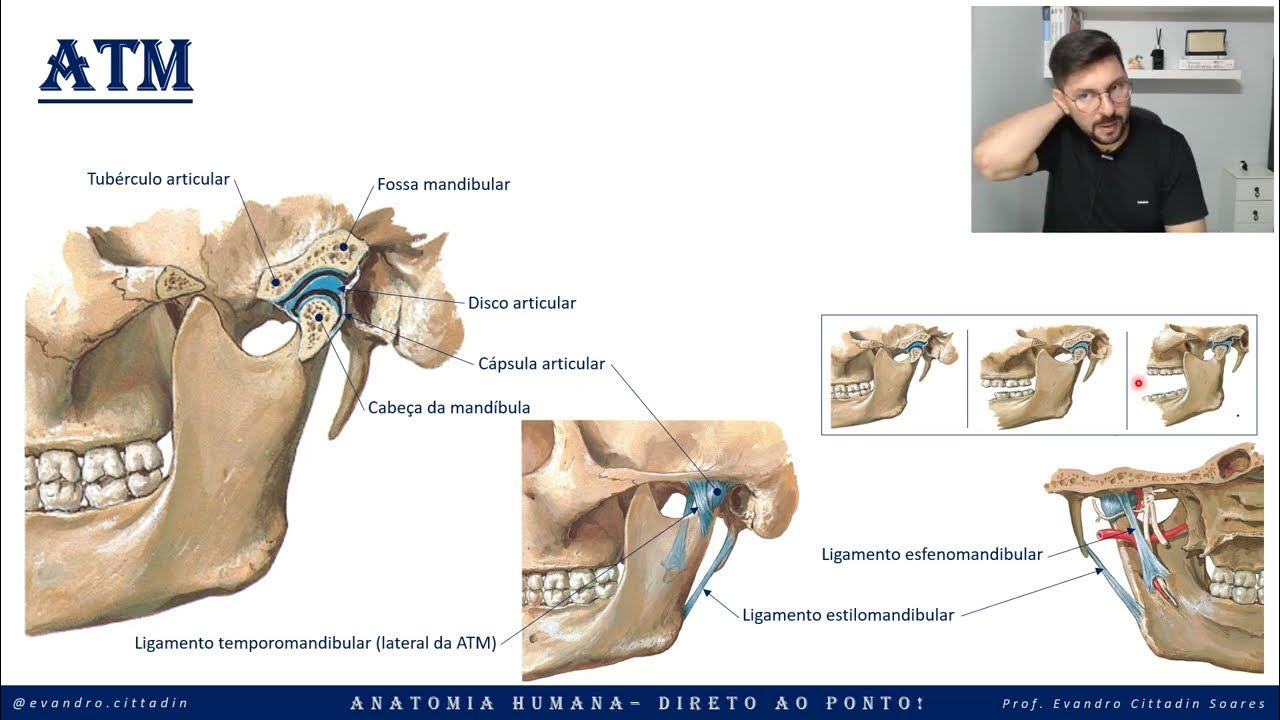Temporomandibular Joint 😲 | Biomechanics Part 2/2
Summary
TLDRThis video explores the biomechanics of the temporomandibular joint (TMJ), focusing on the muscles involved in mouth opening and closing. It details the roles of the lateral pterygoid, suprahyoid, and infrahyoid muscles in facilitating mandibular depression and elevation, with a particular focus on the late phases of mouth opening and closing. The video also highlights the importance of the articular disc’s tension for smooth jaw movement, as well as the hyoid bone’s position during these actions. This comprehensive explanation sheds light on the complex interactions that enable efficient jaw movement.
Takeaways
- 😀 Mouth opening consists of two phases: early phase with mandibular depression and late phase with anterior condylar translation.
- 😀 The lateral pterygoid inferior head is primarily responsible for downward mandibular rotation during mouth opening.
- 😀 The lateral pterygoid superior head controls the anterior translation of the mandibular condyle during the late phase of mouth opening.
- 😀 The superior head of the lateral pterygoid also creates tension on the articular disc, facilitating its anterior slide during mouth opening.
- 😀 The hyoid bone is pulled posteriorly and inferiorly during mouth opening by the suprahyoid and infrahyoid muscles to avoid interference with the mandible.
- 😀 The net pull on the hyoid bone is posterior and inferior, crucial for maximal mouth opening.
- 😀 Mandibular elevation during mouth closing involves the temporalis, masseter, and medial pterygoid muscles.
- 😀 The posterior fibers of the temporalis are responsible for the retraction of the mandible during mouth closing.
- 😀 The suprahyoid and infrahyoid muscles relax during mouth closing, allowing the hyoid bone to return to its original position.
- 😀 Elastic energy stored in the articular disc during mouth opening is released during mouth closing, aiding in the elevation of the mandible.
Q & A
What are the two phases of mouth opening and what occurs during each phase?
-Mouth opening is divided into an early and late phase. The early phase involves bilateral downward mandibular rotation, mainly occurring at the mandibular condyles. The late phase consists of bilateral anterior condylar translation, with a small amount of inferior translation, primarily controlled by the superior head of the lateral pterygoid muscle.
How does the lateral pterygoid muscle contribute to mouth opening?
-The lateral pterygoid muscle, particularly its inferior head, controls downward mandibular rotation during the early phase of mouth opening. The superior head of the lateral pterygoid muscle, which inserts on the articular disc, controls the anterior translation of the mandibular condyle during the late phase of mouth opening.
What role does the hyoid bone play during mouth opening?
-The hyoid bone moves posteriorly and inferiorly during mouth opening to avoid collision with the mandible as it depresses. This movement is facilitated by the contraction of both the suprahyoid and infrahyoid muscles, allowing for maximal mouth opening without obstruction.
Which muscles are involved in the movement of the hyoid bone during mouth opening?
-The suprahyoid muscles pull the hyoid bone posteriorly and superiorly, while the infrahyoid muscles pull it inferiorly. The combined action results in a posterior and inferior shift of the hyoid bone, which is essential for optimal mandibular depression during mouth opening.
What happens during mouth closing in terms of mandibular movement?
-During mouth closing, the early phase involves bilateral posterior condylar translation with a slight superior translation. In the late phase, mandibular elevation occurs through upward condylar rotation, with the combined action of the temporalis, masseter, and medial pterygoid muscles.
Which muscles are involved in mandibular elevation during mouth closing?
-Mandibular elevation during mouth closing involves the combined action of the temporalis, masseter, and medial pterygoid muscles, with the anterior fibers of the temporalis playing a significant role in elevating the mandible.
What is the role of the posterior fibers of the temporalis muscle during mouth closing?
-The posterior fibers of the temporalis muscle are responsible for the retraction of the mandible during mouth closing, moving the mandible posteriorly. The other muscles, such as the masseter and medial pterygoid, do not contribute to this retraction.
How do the suprahyoid and infrahyoid muscles behave during mouth closing?
-During mouth closing, the suprahyoid and infrahyoid muscles relax. This allows the hyoid bone to return to its original position, moving anteriorly and superiorly, in the opposite direction of the pull during mouth opening.
What is the function of the articular disc during mouth opening and closing?
-During mouth opening, tension is applied to the articular disc by the superior head of the lateral pterygoid muscle, allowing the mandibular condyle to translate anteriorly. When closing the mouth, the stored elastic energy in the articular disc is released, helping to elevate the mandible back to its original position.
What is the significance of elastic energy in the articular disc during mouth closing?
-The elastic energy stored in the articular disc during mouth opening (due to tension from the lateral pterygoid muscle) is released during mouth closing. This conversion of elastic energy into kinetic energy helps facilitate the upward movement of the mandible, aiding in mouth closure.
Outlines

Cette section est réservée aux utilisateurs payants. Améliorez votre compte pour accéder à cette section.
Améliorer maintenantMindmap

Cette section est réservée aux utilisateurs payants. Améliorez votre compte pour accéder à cette section.
Améliorer maintenantKeywords

Cette section est réservée aux utilisateurs payants. Améliorez votre compte pour accéder à cette section.
Améliorer maintenantHighlights

Cette section est réservée aux utilisateurs payants. Améliorez votre compte pour accéder à cette section.
Améliorer maintenantTranscripts

Cette section est réservée aux utilisateurs payants. Améliorez votre compte pour accéder à cette section.
Améliorer maintenantVoir Plus de Vidéos Connexes

ATM - Articulação temporomandibular - Sistema articular - Anatomia direto ao ponto!

ATM y Músculos de la Masticación - Anatomía

MÚSCULOS DA ATM #medicina #anatomia #anatomy #medico #fisioterapia #anato #odontologia #odonto

Dentacademy - Anatomi Umum - Sistem Mastikasi - Part 1

Anatomia da Articulação Temporomandibular (ATM) PARTE 1

Анатомия височно-нижнечелюстного сустава - meduniver.com
5.0 / 5 (0 votes)
